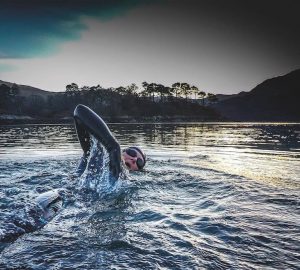Cassie Patten’s clingfilm visualisation technique
Last weekend I went along to a SwimQuest Skills session at Hampton Lido. The session was led by Cassie Patten, who coaches for SwimQuest on some of their swimming holidays and is also a contributor to Outdoor Swimmer. The informativesession consisted of a 30-minute talk by Cassie followed by about an hour in the pool, and then a social BBQ to wrap up the evening.
Cassie started by explaining that when she learnt to swim she was taught her hand should slice into the water thumb first. Current thinking is that a thumb-first entry increases your risk of shoulder injury, and Cassie described (in quite graphic detail) how her professional swimming career was ended by such an injury. Along with many other coaches, she now teaches a finger first entry, with the hand entering in line with the shoulder.
None of this was particularly new to me, nor will be to many readers of Outdoor Swimmer. However, what was new to me is a visualisation technique that Cassie uses to help ensure a smooth and energy efficient hand entry. It’s only a small thing, but I liked it and find it useful when I got in the pool after. There’s even some physics behind it.
Thinking back to your school days, you may remember something called surface tension. Water molecules at the surface only have adjacent molecules below and to the sides. They therefore form stronger bonds to other molecules on the surface than they would do if they were surrounded on all sides. This means it is more difficult to move something through the water surface than it is when it is fully submersed. You can test this yourself by taking something like a needle and carefully placing it on the surface of a glass of water. If you do it right, you can get the needle to float, but as soon as you break the surface tension the needle will sink.
Cassie’s visualisation trick is to imagine the water surface is covered in a layer of clingfilm, which behaves a bit like surface tension, only much stronger. Her aim, when putting her hand into the water at the front of the freestyle stroke, is to punch as small a hole as possible in the clingfilm with her fingers, and then for her hand, wrist, forearm, elbow and upper arm to all slide into the water through the same hole. This, in theory, should save energy compared to trying to break through the clingfilm with your entire arm in one go.
It sounds weird, but I found it helpful. If (like me) you make an inordinate amount of splash as your arms crash into the water, give it a go.
SwimQuest are running more swimming skills sessions throughout the year. Find out more at: swimquest.uk.com/skills/








